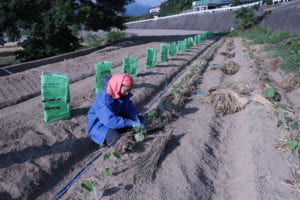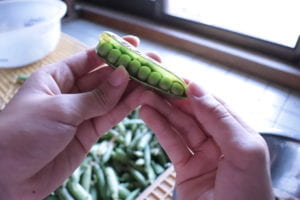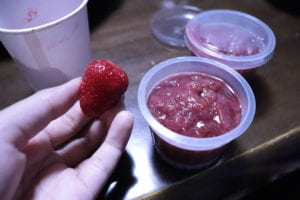Hearing the term ‘food sustainability’ may confuse you. What does that exactly entail? Food security? Sustaining the land/water? Reducing the carbon footprint generated by food production and consumption? Bettering and maintaining human health?
Our answer: It involves all of these issues that intertwine with each other – food production, distribution, and consumption all affect the extent to which food is sustainable (in all security, health and waste), and they all affect each other, one way or another.
Following up from my first reflection, my reflections will focus on two things: some with regards to my personal relationship and connection with food and how that has grown, while others will focus on delving into the heart of food sustainability, by sharing insights from our different experiences here in Japan and reflecting on how these experiences shape my understanding of food and how it can become more sustainable in the current-day context.
Today, I want to share about the farm I mentioned in my previous reflection: Ono Farm. For a little bit of context, we have currently joined the WWOOF (World Wide Opportunities on Organic Farms) programme, which is a platform that allows us (Wwoofers) to be matched with farms (hosts). We chose our farms based on how well they fit into our travel fellowship: they are environmentally conscious and the first is a vegetable farm, then we’re moving on to a poultry/egg farm (which we are currently at), then to a dairy farm, as well as visiting various places in between.
The first farm, Ono farm, is one of the pioneers in organic farming in modern Japan. As we heard over our meaningful dinner conversations, people in Japan mostly farmed organically in the past. However, after the green revolution, most farmers in Japan turned to commercial and more efficient farming methods. This caused a sudden shift in the way farming was done in Japan – commercial fertilisers, pesticides and herbicides boomed in popularity and even now, farmer Masako described how she is sadly greeted with herbicides the moment she walks into the supermarket, and how their neighbours (out of goodwill) offer to spray their fields with herbicides when they are overgrown with weeds.
At the time, it was an amazing innovation: growing food more efficiently, making more food and earning more money off it. Many subsistence farmers saw the potential in turning their farm into something profitable. Unfortunately, as with economics, the price of food fell as well as supply increased with the ease to grow food, causing farming to be deemed as a labor-intensive, low-output job even now.
Most people don’t see, or perhaps choose to ignore the hidden trade-offs that come with these chemical pesticides, fertilisers and herbicides. Its impacts on health are often always dismissed with skepticism. When asked about how they felt about this skepticism, farmer Yuuji replied that it would almost be delusional if you deny that what you pour onto the land where you grow your food wouldn’t affect you when you put it in your body. It’s true – while hard to prove with science, it is basically common sense: would you eat pesticides? (No.) Then should you spray it on what you’re eating? (Definitely not!) The farmers believe that whatever food you make should be something that you would want to eat. Many non-organic farmers nowadays don’t even consume their own produce, rather they sell their produce and buy others’ to consume. This is likely due to the sheer amount of chemicals they see themselves pour onto their crops, and how cheap and easy it is to get other food at supermarkets.
Organic farmers have to embrace the trade offs when making crops without such chemical additives. That means that there are constantly many herbs and grasses competing with their crops, they have to invest in natural fertilisers for the land that are harder to find (for instance, Ono farm uses ground oyster shells – which would otherwise be wasted!) and we often find many pests feasting on their precious crops, such as slugs, birds, ladybugs etc. But as a result, their crops taste way better and they are happy and safe eating their own produce as well. I’m feeling safer and happier too, and I really don’t want to go back to eating non-organic food. When we stopped by Kyoto for a few days, I felt so pained eating at expensive (relative to countryside food/wwoofing) restaurants and yet finding their vegetables so plain as compared to what we had at Ono farm.
 (Protecting the crops with hay – eliminates plastic use!)
(Protecting the crops with hay – eliminates plastic use!)
I am so amazed at their dedication as organic farmers. They had to endure, and still are enduring so many hardships. When they first started out, people thought they were crazy, and the community didn’t accept them with warm open hands. They could only find barren land with weeds growing up to their chest, and had to work really hard every single day to barely produce anything. While they have overcome those initial hardships, farming organically isn’t easy – like I mentioned, pests, weeds and erratic weather (climate change!) can easily ruin their hard work. They can’t sell their produce at exorbitant prices as not many consumers are aware of organic food, and most importantly, they want the food they produce to be more accessible to the public so they try to make the prices more competitive. We see them toiling constantly from day to night every single day while we get tired just from one trip (and they tell us to take breaks while they go farm some more – we were spoiled). They are such amazing people with huge hearts and I constantly feel so inspired by them.
Organic food tastes way better too, but we just don’t notice it. Due to how we season our food, we often miss out on the natural sweetness of fresh crops. Only when we had organic produce at Ono farm did we notice the difference. I normally dislike green peas, but when we had fresh, round and huge peas from the farm that we harvested, I was really surprised at how sweet and juicy it was, unlike any other peas I’ve tasted. I even came to love peas by the end of our stay – yes, that’s how much I enjoyed them, and also when I realised that the food I normally know and taste probably doesn’t truly taste like that. For instance, I never knew that strawberries could have such a strong and pleasant taste – all I’ve known is that it is sweet, sour and juicy, and never more than that, until I had organic strawberries.
 (Beautiful organic peas!)
(Beautiful organic peas!) (These organic strawberries… were so good…)
(These organic strawberries… were so good…)
(to be continued)